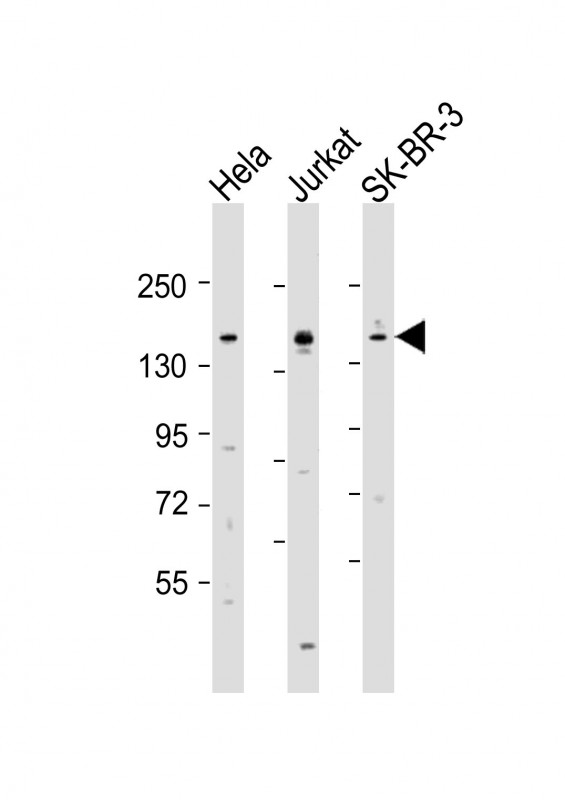FANCD2 Antibody (Center)
Purified Rabbit Polyclonal Antibody (Pab)
- 产品详情
- 实验流程
- 背景知识
Application
| WB, E |
|---|---|
| Primary Accession | Q9BXW9 |
| Reactivity | Human |
| Host | Rabbit |
| Clonality | polyclonal |
| Isotype | Rabbit IgG |
| Calculated MW | 164128 Da |
| Gene ID | 2177 |
|---|---|
| Other Names | Fanconi anemia group D2 protein, Protein FACD2, FANCD2, FACD |
| Target/Specificity | This FANCD2 antibody is generated from a rabbit immunized with a KLH conjugated synthetic peptide between 893-927 amino acids from the Central region of human FANCD2. |
| Dilution | WB~~1:2000 E~~Use at an assay dependent concentration. |
| Format | Purified polyclonal antibody supplied in PBS with 0.09% (W/V) sodium azide. This antibody is purified through a protein A column, followed by peptide affinity purification. |
| Storage | Maintain refrigerated at 2-8°C for up to 2 weeks. For long term storage store at -20°C in small aliquots to prevent freeze-thaw cycles. |
| Precautions | FANCD2 Antibody (Center) is for research use only and not for use in diagnostic or therapeutic procedures. |
| Name | FANCD2 |
|---|---|
| Synonyms | FACD |
| Function | Required for maintenance of chromosomal stability (PubMed:11239453, PubMed:14517836). Promotes accurate and efficient pairing of homologs during meiosis (PubMed:14517836). Involved in the repair of DNA double-strand breaks, both by homologous recombination and single-strand annealing (PubMed:15671039, PubMed:15650050, PubMed:30335751, PubMed:36385258). The FANCI-FANCD2 complex binds and scans double-stranded DNA (dsDNA) for DNA damage; this complex stalls at DNA junctions between double-stranded DNA and single-stranded DNA (By similarity). May participate in S phase and G2 phase checkpoint activation upon DNA damage (PubMed:15377654). Plays a role in preventing breakage and loss of missegregating chromatin at the end of cell division, particularly after replication stress (PubMed:15454491, PubMed:15661754). Required for the targeting, or stabilization, of BLM to non-centromeric abnormal structures induced by replicative stress (PubMed:15661754, PubMed:19465921). Promotes BRCA2/FANCD1 loading onto damaged chromatin (PubMed:11239454, PubMed:12239151, PubMed:12086603, PubMed:15115758, PubMed:15199141, PubMed:15671039, PubMed:18212739). May also be involved in B-cell immunoglobulin isotype switching. |
| Cellular Location | Nucleus Note=Concentrates in nuclear foci during S phase and upon genotoxic stress. At the onset of mitosis, excluded from chromosomes and diffuses into the cytoplasm, returning to the nucleus at the end of cell division. Observed in a few spots localized in pairs on the sister chromatids of mitotic chromosome arms and not centromeres, one on each chromatids. These foci coincide with common fragile sites and could be sites of replication fork stalling. The foci are frequently interlinked through BLM-associated ultra-fine DNA bridges. Following aphidicolin treatment, targets chromatid gaps and breaks |
| Tissue Location | Highly expressed in germinal center cells of the spleen, tonsil, and reactive lymph nodes, and in the proliferating basal layer of squamous epithelium of tonsil, esophagus, oropharynx, larynx and cervix. Expressed in cytotrophoblastic cells of the placenta and exocrine cells of the pancreas (at protein level). Highly expressed in testis, where expression is restricted to maturing spermatocytes |
For Research Use Only. Not For Use In Diagnostic Procedures.
Provided below are standard protocols that you may find useful for product applications.
BACKGROUND
Required for maintenance of chromosomal stability. Promotes accurate and efficient pairing of homologs during meiosis. Involved in the repair of DNA double-strand breaks, both by homologous recombination and single-strand annealing. May participate in S phase and G2 phase checkpoint activation upon DNA damage. Plays a role in preventing breakage and loss of missegregating chromatin at the end of cell division, particularly after replication stress. Required for the targeting, or stabilization, of BLM to non-centromeric abnormal structures induced by replicative stress. Promotes BRCA2/FANCD1 loading onto damaged chromatin. May also be involved in B-cell immunoglobulin isotype switching.
REFERENCES
Timmers C.,et al.Mol. Cell 7:241-248(2001).
Ota T.,et al.Nat. Genet. 36:40-45(2004).
Bechtel S.,et al.BMC Genomics 8:399-399(2007).
Garcia-Higuera I.,et al.Mol. Cell 7:249-262(2001).
Taniguchi T.,et al.Blood 100:2414-2420(2002).
终于等到您。ABCEPTA(百远生物)抗体产品。
点击下方“我要评价 ”按钮提交您的反馈信息,您的反馈和评价是我们最宝贵的财富之一,
我们将在1-3个工作日内处理您的反馈信息。
如有疑问,联系:0512-88856768 tech-china@abcepta.com.























 癌症的基本特征包括细胞增殖、血管生成、迁移、凋亡逃避机制和细胞永生等。找到癌症发生过程中这些通路的关键标记物和对应的抗体用于检测至关重要。
癌症的基本特征包括细胞增殖、血管生成、迁移、凋亡逃避机制和细胞永生等。找到癌症发生过程中这些通路的关键标记物和对应的抗体用于检测至关重要。 为您推荐一个泛素化位点预测神器——泛素化分析工具,可以为您的蛋白的泛素化位点作出预测和评分。
为您推荐一个泛素化位点预测神器——泛素化分析工具,可以为您的蛋白的泛素化位点作出预测和评分。 细胞自噬受体图形绘图工具为你的蛋白的细胞受体结合位点作出预测和评分,识别结合到自噬通路中的蛋白是非常重要的,便于让我们理解自噬在正常生理、病理过程中的作用,如发育、细胞分化、神经退化性疾病、压力条件下、感染和癌症。
细胞自噬受体图形绘图工具为你的蛋白的细胞受体结合位点作出预测和评分,识别结合到自噬通路中的蛋白是非常重要的,便于让我们理解自噬在正常生理、病理过程中的作用,如发育、细胞分化、神经退化性疾病、压力条件下、感染和癌症。






